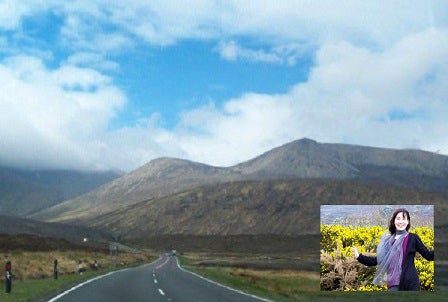A significant aspect of researching or working with archival material is the connection that forms between items from the past and individuals looking at them in the present. Reading through collections of personal papers especially develops a sense of familiarity and understanding, if not empathy, with past lives. People reach out from past times through journals, memoirs, letters, photographs and artifacts. Learning about others’ lives is always fascinating; but it is even more delightful to discover a shared experience.
So it was when I read this haunting description of the Isle of Skye by the poet Ned O’Gorman, which took me back to my own visit there. His graphic prose uncannily recalls images from my own memory.
Skye
The Isle of Skye is an invention of the subconscious. There are places there of salty light and terrifying natural grace. It is the interior of the land, the assembly of rocks and trees, streams and clouds, that brought me to thoughts of genesis and prehistory. It answered the call of my spirit that hung like a fragile bridge over the new worlds I blustered through.
Beauty is mated on Skye with terror. I wrapped myself in a scarf and wandered inland. The farther I got from the sea the colder and more remote the mainland became. Ocean and islands fell like Ice Age scars and long dead plants in the distance; I was surrounded by ceremonies merely held in suspension until the second coming of some past time. A storm gathered. Beasts seemed to watch behind the trees and rock strewn fields. I walked through a forest of three-foot, stunted pines that would never grow taller for they had been pelted the day of their planting by hail and freezing rains.
I fled back to the mainland and took a train to London.
--Excerpt from the unpublished manuscript of
an autobiography-cum-travel journal by Ned O’Gorman,
in the Ned O’Gorman papers 4,
GTM050910, Box 1, Folders 98-99.

Archivist "lost" in the gorse
on the Isle of Skye.
Ned O'Gorman was born Edward Charles O’Gorman in New York City on September 26, 1929. He received a B.A. from St. Michael's College in 1950 and later an M.A. from Columbia University. Winner of Guggenheim fellowships in 1956 and 1962, O’Gorman was also awarded the Lamont Poetry Selection Award in 1958. These early achievements culminated in the first publication of his collected poems, The Night of the Hammer (1959). From 1962 to 1965, O’Gorman was editor of the Catholic literary magazine Jubilee. He also taught at Iona College in New York (1957), and Tougaloo College in Mississippi (1965-1966).
In 1966, O’Gorman founded the Children’s Storefront School in Harlem, New York. Inspired by philosopher and social critic Paul Goodman, the privately funded school is a lasting and innovative contribution to the education of disadvantaged children, accepting any who wish to attend, and providing a place where O’Gorman believed “the senses of children [can] thrive…or, at the very least, exist.” Development and his involvement with the school are recorded by O’Gorman in The Storefront: A Community of Children on 129th Street and Madison Avenue (1970). His critically acclaimed book, The Children are Dying (1978), represents his unflinching advocacy of children in Harlem.
Ned O’Gorman died in 2014. The Ned O’Gorman papers Parts 1, 2, 3, and 4 are available for research at the Booth Family Center for Special Collections. A commemorative exhibition, Ned O’Gorman: through a poet’s lens is currently on view (through January 2018) at the Booth Family Center for Special Collections.
--Lisette Matano, Manuscripts Archivist
February 2, 2018
